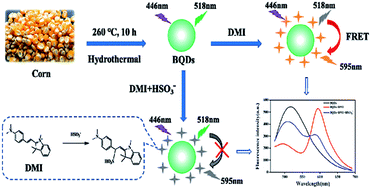A new ratiometric fluorescence assay based on resonance energy transfer between biomass quantum dots and organic dye for the detection of sulfur dioxide derivatives†
Abstract
Sulfur dioxide (SO2) is considered as the fourth gas signal molecule after nitric oxide (NO), carbon monoxide (CO) and hydrogen sulfide (H2S). It plays important roles in several physiological processes. Therefore, the design and synthesis of nanoprobes for the detection of SO2 derivatives in cells is of great significance. Herein, we report a new ratiometric fluorescence nanoprobe based on resonance energy transfer (RET) between biomass quantum dots (BQDs) and organic dye (DMI) for the detection of SO2 derivatives. The proposed ratiometric fluorescence assay allows the determination of HSO3− in the range of 1.0 to 225 μM with a detection limit of 0.5 μM. Importantly, the proposed ratiometric fluorescence nanoprobe exhibits a high photostability and good selectivity for HSO3− over other chemical species including H2S and biological mercaptans. Quantitation of HSO3− in cell lysates by using the nanoprobe is demonstrated.



 Please wait while we load your content...
Please wait while we load your content...